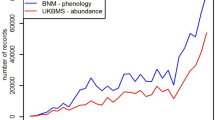Abstract
Many butterfly populations are monitored by counting the number of butterflies observed while walking transects during the butterfly’s flight season. Methods for estimating population abundance from these transect counts are appealing because they allow rare populations to be monitored without capture–recapture studies that could harm fragile individuals. An increasingly popular method for estimating abundance from transect counts relies on strong assumptions about the counting process and the processes that govern butterfly population dynamics. Here, we study the statistical performance of this method when underlying model assumptions are violated. We find that estimates of population size are robust to departures from underlying model assumptions, but that the uncertainty in these estimates (i.e., confidence intervals) is substantially underestimated. Alternative bootstrap and Bayesian methods provide better measures of the uncertainty in estimated population size, but are conditional upon knowledge of butterfly detectability. Because of these requirements, a mixed approach that combines data from small capture–recapture studies with transect counts strikes the best balance between accurate monitoring and minimal injury to individuals. Our study is motivated by monitoring studies for St. Francis satyr (Neonympha mitchelli francisci), a rare and relatively immobile butterfly occurring only in the sandhills region of south-central North Carolina, USA.


Similar content being viewed by others
References
Boughton DA (2000) The dispersal system of a butterfly: a test of source–sink theory suggests the intermediate-scale hypothesis. Am Nat 156:131–144
Brown JA, Boyce MS (1998) Line transect sampling of Karner blue butterflies (Lycaeides melissa samuelis). Env Ecol Stat 5:81–91
Buckland ST, Anderson DR, Burnham KP, Laake JL, Borchers DL, Thomas L (2001) Introduction to distance sampling—estimating abundance of biological populations. Oxford University Press, Oxford
Efron B, Tibshirani RJ (1993) An introduction to the bootstrap. Chapman & Hall, London
Gelman A, Rubin DB (1992) Inference from iterative simulation using multiple sequences. Stat Sci 7:457–511
Haddad NM, Kuefler D, Hudgens BR (2005) Monitoring protocal for St. Francis’ satyr: final report for the 2004 field season. Report to the Department of Defense. NC State University, Raleigh, NC
Manly BFJ (1974) Estimation of stage-specific survival rates and other parameters for insect populations developing through several stages. Oecologia 15:277–285
Mattoni R, Longcore T, Zonneveld C, Novotny V (2001) Analysis of transect counts to monitor population size in endangered insects. J Insect Conserv 5:197–206
McCullach P, Nelder JA (1989) Generalized linear models, 2nd edn. Chapman & Hall, London
Murphy DD (1988) Are we studying our endangered butterflies to death? J Res Lep 26:236–239
Parshall DK, Kral TW (1989) A new subspecies of Neonympha mitchelli (French) (Satyridae) from North Carolina. J Lep Soc 43:114–119
Pollard E (1977) A method for assessing change in the abundance of butterflies. Biol Conserv 12:115–132
Pollard E, Yates TJ (1993) Monitoring butterflies for ecology and conservation. Chapman & Hall, London
Pollard E, Elias DO, Skelton MJ, Thomas JA (1975) A method of assessing the abundance of butterflies in Monks wood national nature reserve in 1973. Entomol Gaz 26:79–88
Pollock KH, Nichols JD, Simons TR, Farnsworth GL, Bailey LL, Sauer JR (2002) Large scale wildlife monitoring studies: statistical methods for design and analysis. Environmetrics 13:105–119
Rothery P, Roy DB (2001) Application of generalized additive models to butterfly transect count data. J Appl Stat 28:897–909
Singer MC, Wedlake P (1981) Capture does affect probability of recapture in a butterfly species. Ecol Entomol 6:215–216
Thomas JA (1983) A quick method for estimating butterfly numbers during surveys. Biol Conserv 27:195–211
Thomas JA (2005) Monitoring change in the abundance and distribution of insects using butterflies and other indicator groups. Philos Trans R Soc B 360:357
Wedderburn RWM (1974) Quasi-likelihood functions, generalized linear models and the Gauss–Newton method. Biometrika 61:439–447
Zonneveld C (1991) Estimating death rates from transect counts. Ecol Entomol 16:115–121
Zonneveld C, Longcore T, Mulder C (2003) Optimal schemes to detect the presence of insect species. Conserv Biol 17:476–487
Acknowledgments
We thank Justin Calabrese, Chris Damiani, Sujit Ghosh, Travis Longcore, Bryan Manly, Ken Pollock, Leslie Ries, Cor Zonneveld, and two anonymous reviewers for helpful comments and discussion. This work was funded by Fort Bragg’s Endangered Species Branch and Natural Resources Division and the National Science Foundation, with administrative support provided by the North Carolina Cooperative Fish and Wildlife Research Unit.
Author information
Authors and Affiliations
Corresponding author
Appendix: technical description of Bayesian model
Appendix: technical description of Bayesian model
Let d = 1,..., D be a daily time index, where days 1 and D are the days of the first and last transect counts, respectively. Let X(d) be the number of butterflies that emerge on day d, let Y(d) be the number of butterflies alive on day d, and let Z(d) (the data) be the number of butterflies counted on day d if a transect count was conducted. To make the notation more compact, we use the vector notation X = [X(1),..., X(D)], Y = [Y(1),..., Y(D)], and Z = [Z(t 1),..., Z(t n )], where t 1,..., t n are the days of the n transect counts. In keeping with standard Bayesian practice, we parameterize the variance of the emergence distribution by its inverse τ = σ −2. Also, let ξ be a shape parameter that indicates whether the emergence distribution is normal (ξ = 0) or logistic (ξ = 1). Let \({\varvec{\theta} = (N, \mu, \tau, \varphi, \xi)}\) be a vector that contains the unknown parameters.
Let π(·) denote a probability distribution. Our goal is to estimate \({\pi({\varvec{\theta}} | {\bf Z})},\) the posterior distribution of the unknown parameters given the data. This marginal posterior distribution can be found by integrating X and Y out of the full posterior \({\pi({\varvec{\theta}}, {\bf X}, {\bf Y} | {\bf Z})}.\) The full posterior is proportional to the product of likelihood of the data and the prior distribution
The terms on the right-hand side of Eq. 2 can be simplified by observing that the distribution of the data Z depends only on Y, and by factoring the prior:
The first term on the right of Eq. 3 is the probability distribution of the data given the actual (unobserved) dynamics, and can be written as
where π[Z(t i )| Y(t i )] is the appropriate probability model for the transect counts. For SFS, we use a beta-binomial distribution with a fixed overdispersion parameter η.
The second term on the right of Eq. 3 is the probability distribution of the actual butterfly dynamics given unobserved parameters, and comes directly from a modified version of Zonneveld’s model. First, the vector of emergence times X has a multinomial distribution with parameters N and p 1,..., p D , where p d is the probability of emergence on day d. The emergence probabilities p 1,..., p D are determined by discretizing the underlying continuous distribution for emergence times,
Second, the number of butterflies flying on day d, Y(d), is the sum of the butterflies that emerged on day d, X(d), plus those butterflies that were flying on day d−1 and survived. In equations,
For each SFS time series, we used the following proper noninformative priors for μ, τ, and N
where N 0 is a relatively large value (5,000). ξ had equal prior probability of indicating either a logistic or normal distribution. The prior for the daily survival probability ϕ was based on capture–recapture studies for the same subpopulations in 2002 and 2003
We approximated the posterior distribution numerically using the Markov chain Monte Carlo (MCMC) algorithm described below. We used separate Metropolis–Hastings updating steps for the parameters μ, τ, and ξ, as well as the parameter blocks (ϕ, N, X, Y), (N, X, Y), (X, Y), and Y. N, X, and Y were updated as blocks because of the conditional dependence structure of the model, while ϕ was updated in a block because of its strong posterior correlation with N. Updates of the single parameters used standard proposal distributions (folded normals for μ and τ; because ξ is a binary variable, its proposal was whatever the current value was not), but block updates used non-standard proposals, and so we describe these here. In what follows, we use primes (′) to denote proposed parameter values. In all cases, substantial cancellation follows from the model factorization (Eq. 3), which eases the calculation of the acceptance ratio considerably.
To update the block (N, X, Y), we first flip a fair coin to decide whether to add (N′ = N + 1) or subtract (N′ = N − 1) an individual, and then roll a fair D-sided die to determine the day on which an individual is added or subtracted. We add or subtract the individual from both X and Y. To keep the proposal density symmetric, moves to regions of zero prior probability [e.g., X′(d) = −1] are allowed, but are automatically rejected because the acceptance ratio is zero. To update the block (ϕ, N, X,Y), we propose a value ϕ′ separately, but evaluate the entire proposed move to ϕ′, N′, X′, and Y′ at once.
We update the block (X, Y) by moving a randomly selected individual’s emergence time forward or backward by a day. To do so, we first choose the day from which an individual is moved, d *, with probability P(d * = d) = X(d)/N. If 2 ≤ d * ≤ N − 1, we flip a fair coin to determine whether to move that individual’s emergence time forward or backward by a day. If d * = 1 or d * = N, we move the individual’s emergence time ahead or back by a day, respectively. For example, if we choose to move an individual’s emergence time one day later, then X′(d *) = X(d *) − 1, X′(d * + 1) = X(d * + 1) + 1, Y′(d *) = Y(d *) − 1, and Y′(d * + 1) = Y(d * + 1) + 1. Not all moves of this type result in a legal X and Y; such moves are considered but are automatically rejected for lack of prior support. The proposal distribution is not symmetric, and must be factored into the acceptance ratio.
To update Y, d * is selected at random from 2,..., N (each with equal probability), and a fair coin is flipped to determine whether to increase or decrease Y(d *) by 1. Again, not all possible moves result in legal combinations of Y and X, and illegal moves are considered but are automatically rejected for lack of prior support. The proposal distribution is symmetric.
Ten separate chains were run from different starting values, and convergence was monitored by Gelman and Rubin’s (1992) potential scale reduction factor. For the fits to SFS data, Monte Carlo standard errors of posterior medians were less than 2.5% of posterior standard errors in all cases.
Rights and permissions
About this article
Cite this article
Gross, K., Kalendra, E.J., Hudgens, B.R. et al. Robustness and uncertainty in estimates of butterfly abundance from transect counts. Popul Ecol 49, 191–200 (2007). https://doi.org/10.1007/s10144-007-0034-8
Received:
Accepted:
Published:
Issue Date:
DOI: https://doi.org/10.1007/s10144-007-0034-8




